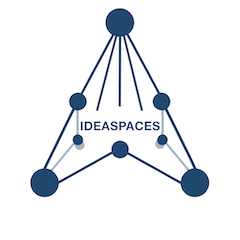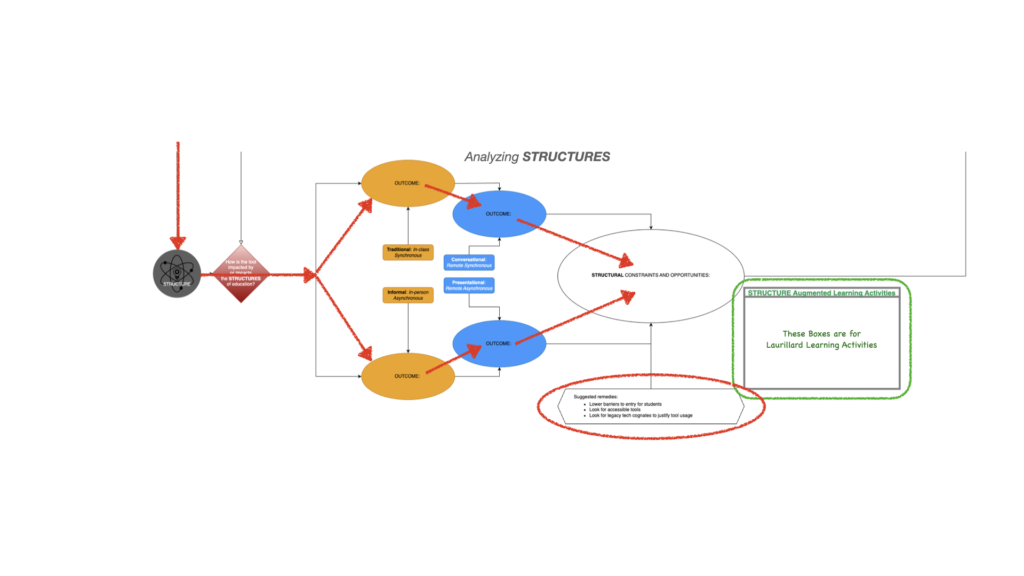| Overview | Analyzing SPACE | Analyzing TIME |
| Analyzing STRUCTURE | Synthesizing IdeaSpaces | Analyzing Learning Activities |
To use the tool, simply go to https://bit.ly/toolaugmentationtool, hover your cursor over the bottom and select the pencil (edit). This will download an editable copy to your desktop. You will need to either download the Diagrams.net app or upload the file to their online app.
All technologies operate within STRUCTURES. Humans construct these structures to facilitate interchange within and between systems. Structures are also tools, albeit very complex ones. It is possible to adapt structures to the needs of individuals, but they are conservative and resistant to change.
Structures form context. Tools can either change that context or facilitate the needs of their users within a particular context. Either way, we cannot ignore them. The success or failure of tools in reshaping TIME and SPACE depend on the context in which we implement them.
Human beings are also creatures of habit and structures provide pathways of regularized interactions that create inertia, especially in larger organizations. Tools cannot change this reality. If they come into conflict with this inertia directly, they are often discarded, regardless of the utility they may provide to any individual or groups of individuals within the larger structure.
The purpose of this section of the Tool Augmentation Tool is twofold.
- It is critical to analyze how any tool will interact with the structure.
- Analysis of tools and tasks may also point to ways in which we can adjust the structure itself to better support individual innovation and learning.
Structures shape the limits of all four modes of interaction (traditional, conversational, informal, and presentational). Therefore, it is important to distinguish them in this part of your analysis.
For instance, let’s say you construct a brilliantly welcoming, informal space, but your management prioritizes cleanliness and order over spontaneous interactions. The users of that space will probably feel unwelcome and choose not to use it.
No matter carefully constructed the environment you created is, this will destroy its utility. If your corporate or campus structure works against your tool, its failure is almost assured. When you suggest similar innovations in the future, they will probably be dismissed in part because of the failure of past initiatives, regardless of where responsibility for that failure lives.
Structures are very change resistant and it is important to have at least a basic understanding of systemic change or resistance to change when implementing any large-scale tool into an environment. Individuals sometimes can work around structural impediments (although they shouldn’t have to) but to create effective group work environments, there must be a level of synergy between the structure and the tool.
Donella Meadows provides an incisive approach to analyzing systems in her article “Leverage Points: Places to Intervene in a System.” I encourage you to review this article and consider the level at which your tool is likely to challenge the systems in which you are trying to implement them and the level of resistance that is likely to engender.
For this part of the exercise, it is essential to interact with those responsible for maintaining structures in the environment in which you are trying to employ the tool being analyzed. Look for opportunities where flexibility can create synergistic outcomes.
Also consider implementing tools that don’t threaten structures directly and instead drive change through osmosis. Environments that create freedom for users often generate pressure on systems to get out of the way and allow that freedom to flourish. This is especially true when goals are clearly articulated by leadership, and you can tie the tool to those goals explicitly.
We should use goals as tools for adaptation, not as clubs to threaten the structure. No matter the circumstances, structural buy-in is preferable to acquiescence and subsequent passive resistance. Structures have a way of biting back. We must be sensitive to these realities and create adaptable tools and strategies with this reality always in mind.
Suggested remedies to structural barriers/realities:
- Lower barriers to entry for users, particularly those forced to use the tool
- Look for accessible tools
- Look for legacy tech cognates to justify tool usage to the rest of the system


